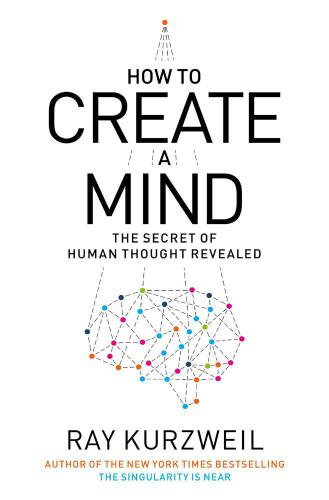
How to Create a Mind
The Secret of Human Thought Revealed
کتاب های مرتبط
- اطلاعات
- نقد و بررسی
- دیدگاه کاربران
نقد و بررسی

October 22, 2012
Bringing together contemporary theories and research in cognitive neuroscience and artificial intelligence, Kurzweil (The Singularity is Near) provides insight into how the human brain functions, while speculating on the possibilities and philosophical implications of creating a nonbiological mind. Underlying this analysis is the Pattern Recognition Theory of Mind, a process in the neocortex, the seat of higher brain functions such as perception, memory, and language and, by extension, consciousness. Kurzweil underscores that any meaningful progress in artificial intelligence is indebted to an understanding of these processes and re-engineering them in nonbiological artificial forms such as Watson, the computer that defeated two of Jeopardy's best players. Like Watson, he says, our brain contains no hidden secretsâit functions by hierarchical statistical analysis, that is, computing. While his descriptions of the human cognitive apparatus and current frontiers of creating a non-biological brain are illuminating, Kurzweil's speculations that eventually "most of our thinking will be in the cloud" and "we will merge with the intelligent technology we are creating," seem so uncritically optimistic about the possibilities of our technologies, as to become mystifying. Agent: Loretta Barrett, Loretta Barrett Books. (Nov.).

September 15, 2012
A pioneering developer of optical character recognition and text-to-speech software explores the possibility of creating a synthetic neocortex that could surpass the human mind. Kurzweil (The Singularity Is Near: When Humans Transcend Biology, 2005, etc.) bases his prediction on modern insights into how the brain has evolved a hierarchical pattern-recognition structure. We perceive the bare outline of events and reconstruct memories in an ordered sequence, and our ability to fill in the blanks provides the foundation for conscious experience. "We are constantly predicting the future and hypothesizing what we will experience," writes the author. "This expectation influences what we actually perceive." Kurzweil estimates that at birth, the neocortex contains 300 million pattern processors connected horizontally and vertically, which allow us to connect patterns. In his opinion, it is these processors, rather than the neurons of which they are composed, that are the fundamental units of the neocortex. They allow us to fill out an increasingly complex picture of reality, enabling us to rapidly evaluate our environment and then confirm our hypothesis by checking out the details. Then we are able to respond rapidly to changes in our environment by creating new technologies. Why not create a synthetic extension of our brain using advanced computer technology? It could "contain well beyond a mere 300 million processors," perhaps as many as a billion or a trillion. Our dependence upon search engines and other technology is a harbinger of a future in which we will not only outsource information storage but directly enhance our mental functioning. In a parallel development, Kurzweil and other software developers are designing more advanced computers based on complex modular functioning. A fascinating exercise in futurology.
COPYRIGHT(2012) Kirkus Reviews, ALL RIGHTS RESERVED.

November 1, 2012
As inventor, futurist, and noted author of several books on technology, Kurzweil has often pushed the boundaries of convention and stirred controversy with his visionary ideas. Guaranteed to trigger still more debate, his latest work expands on a theme first introduced in his best-seller, The Age of Intelligent Machines (1989); namely, a proposed project to reverse-engineer the human mind and use that information to build superintelligent computers to solve the world's thorniest problems. Arguing against the prevailing notion that the brain is simply too complex to be replicated in machine form, either in hardware or software, Kurzweil points out how recent, groundbreaking scientific advances, from mapping the human genome to 3D molecular imaging, have resulted in exponential technological growth. On his way to demonstrating the inevitability of computer intelligence that outstrips its human creators, Kurzweil dissects such topics as the nature of consciousness and transcendent abilities like love and creativity, and seeks to rebut his potential critics. While his prose sometimes founders when analyzing abstract data, Kurzweil's extrapolation of technology's breathtaking potential remains provocative and inspiring.(Reprinted with permission of Booklist, copyright 2012, American Library Association.)

























دیدگاه کاربران